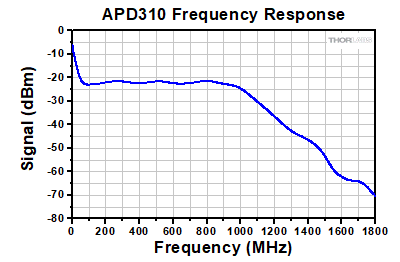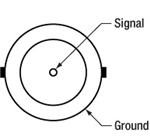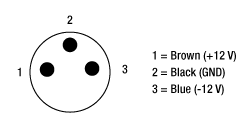
Free-Space InGaAs Avalanche Photodetectors

- High-Speed Response up to 1.6 GHz
- Conversion Gains up to 9.0 × 106 V/W
- Wavelength Ranges Covering 850 to 1700 nm
- Temperature-Compensated and Variable Gain Versions Available
APD450C
High Speed, Temperature-
Compensated APD
APD310
High-Speed APD
APD130C
Temperature-Compensated APD
APD430C
Variable-Gain,
Temperature-Compensated APD
OVERVIEW
| Free-Space InGaAs APD Selection Guide | |||
|---|---|---|---|
| Item # | Wavelength Range |
Bandwidth (3 dB) |
Type (Quick Links) |
| APD130C(/M) | 900 - 1700 nm | DC - 50 MHz | Temperature Compensated |
| APD410C(/M) | DC - 10 MHz | Variable Gain, Temperature Compensated |
|
| APD430C(/M) | DC - 400 MHz | ||
| APD450C | 1260 - 1620 nm | 0.3 - 1600 MHz | |
| APD310 | 850 - 1650 nm | 5 - 1000 MHz | Variable Gain, Temperature Compensated, High Speed |
Features
- Noise Equivalent Powers (NEP) as Low as 0.12 pW/√Hz
- Max Bandwidth up to 1.6 GHz at 3 dB
- Temperature-Compensated Versions Provide M Factor Stability of ≤±3% Over 18 to 28 °C
- Variable Gain Detectors Available: M Factor from 4 to 20 or 2 to 10
- Free-Space Optical Input with Internal SM05 and External SM1 Threading for Lens Tubes
- Power Supply Included
Thorlabs' Free-Space InGaAs Avalanche photodetectors (APDs) are designed to offer increased sensitivity and lower noise compared to standard PIN detectors, making them ideal for applications with low optical power levels. In addition to our standard APDs, versions featuring variable gain (i.e., M factor) and/or temperature compensation are offered.
In general, avalanche photodiodes use an internal gain mechanism to increase sensitivity. A high reverse bias voltage is applied to the diodes to create a strong electric field. When an incident photon generates an electron-hole pair, the electric field accelerates the electrons, leading to the production of secondary electrons by impact ionization. The resulting electron avalanche can produce a gain factor of several hundred times, described by a multiplication factor, M, that is a function of both the reverse bias voltage and temperature. In general, the M factor increases with lower temperatures and decreases with higher temperatures. Similarly, the M factor will increase when the reverse bias voltage is raised and decrease when the reverse bias voltage is lowered.
| Avalanche Photodiode Selection Guidea |
|---|
| Free-Space Si APDs |
| Fiber-Coupled Si APDs |
| Free-Space InGaAs APDs |
| Fiber-Coupled InGaAs APDs |
Our APD130C(/M) temperature-compensated APD features an integrated thermistor that adjusts the bias voltage to compensate for the effect of temperature changes on the M factor. In addition to being temperature compensated, the APD410C(/M), APD430C(/M), and APD450C variable-gain APDs allow the reverse bias voltage across the diode to be adjusted via a rotary knob on the side of the housing, which varies the M factor continuously from 4 to 20.
For extremely light-sensitive applications, Thorlabs offers Menlo Systems' APD310 variable-gain, high-sensitivity avalanche photodetector, which offers high-speed response up to 1 GHz.
A complete list of all of our APDs can be found on the Selection Guide tab. Please note that our Single Photon Detectors are the only avalanche photodetectors suitable for single photon counting.
APDXXXC SPECS
| Item # | APD130C(/M) | APD410C(/M) | APD430C(/M) | APD450C |
|---|---|---|---|---|
| Detector Type | InGaAs APD | |||
| Wavelength Range | 900 - 1700 nm | 1260 - 1620 nm | ||
| Output Bandwidth (3 dB) | DC - 50 MHz | DC - 10 MHz | DC - 400 MHz | 0.3 - 1600 MHz |
| Active Area Diameter | 0.2 mm | 75 µm with Ø1.5 mm Ball Lens | ||
| Typical Max Responsivity | 9 A/W @ 1500 nm (M = 10)a | 18 A/W @ 1550 nm (M = 20) | 9 A/W @ 1550 nm (M = 10) | |
| M Factorb | 10 | 4 - 20 (Continuously Adjustable) | 2 - 10 (Continuously Adjustable) | |
| M Factor Temperature Stabilityc | ±2% (Typical); ±3% (Max) | |||
| Transimpedance Gain | 50 kV/A (50 Ω Termination)d 100 kV/A (High-Z Termination) |
250 kV/A (50 Ω Termination)d 500 kV/A (High-Z Termination) |
5 kV/A (50 Ω Termination)d 10 kV/A (High-Z Termination) |
5 kV/A (50 Ω Termination) |
| Max Conversion Gaine,f | 0.9 × 106 V/W | 9.0 × 106 V/W | 1.8 × 105 V/W | 45 × 103 V/W |
| CW Saturation Power | 4.2 µW | 0.45 µW @ 1550 nm (M = 20) 2.25 µW @ 1550 nm (M = 4) |
22 µW @ 1550 nm (M = 20) 110 µW @ 1550 nm (M = 4) |
0.1 mW @ 1550 nm (M=10) 0.5 mW @ 1550 nm (M=2) |
| Max Input Powerg | 1 mW | |||
| Minimum NEPh | 0.46 pW/√Hz (DC - 50 MHz) | 0.12 pW/√Hz (DC - 10 MHz) | 0.45 pW/√Hz (DC - 100 MHz) | 1.1 pW/√Hz (0.3 - 1600 MHz) |
| Integrated Noisei | 3.3 nW (RMS, DC - 50 MHz) | 0.38 nW (RMS, DC - 10 MHz) | 17 nW (RMS, DC - 400 MHz) | 35 nW (0.3 - 1600 MHz) |
| Electrical Output | 50 Ω BNC | 50 Ω SMA | ||
| Max Output Voltage Swing | 1.8 V (50 Ω Termination) 3.6 V (High-Z Termination) |
2.0 V (50 Ω Termination) 4.1 V (High-Z Termination) |
2.0 V (50 Ω Termination) | |
| DC Offset Electrical Output | < ±15 mV | < ±25 mV | < ±3 mV | N/A |
| Included Power Supplyj | ±12 V @ 250 mA (100/120/230 VAC, 50 - 60 Hz, Switchable) | |||
| General | ||||
| Operating Temperature Range | 0 to 40 °C (Non-Condensing) | |||
| Storage Temperature Range | -40 to 70 °C | |||
| Dimensions (H x W x D) | 2.97" x 2.00" x 1.08" (75.5 mm x 50.8 mm x 27.4 mm) |
2.97" x 2.20" x 1.09" (75.5 mm x 55.8 mm x 27.6 mm) |
2.83" x 2.22" x 1.08" (72.0 mm x 56.3 mm x 27.4 mm) |
|
APD310 SPECS
| Item # | APD310 |
|---|---|
| Detector Type | InGaAs APD |
| Optical Input | Free Spacea |
| Wavelength Range | 850 - 1650 nm |
| Damage Threshold | 10 mW |
| Active Area Diameter | 0.04 mm |
| Frequency Range | 1 MHz - 1800 MHz |
| 3 dB Bandwidth | 5 MHz - 1000 MHz |
| Rise Time | 500 ps |
| Conversion Gain (Max)b | 2.5 x 104 V/W @ 1 GHz, 1500 nm |
| NEP (Calculated)c | 13.3 pW/√Hz |
| Dark State Noise Leveld | -80 dBm |
| M Factor | 30 |
| Typical Max Responsivity | 0.9 A/W @ 1550 nm |
| Output Impedance | 50 Ω |
| Output Connector | BNC |
| Output Coupling | AC |
| Current Consumption (Max) | 200 mA |
| Supply Voltage | +12 to +15 Ve |
| Operating Temperature | 10 to 40°C |
| Storage Temperature | -20 to +85 °C |
| Storage Humidity | 10% to 90% RH |
| Dimensions | 60 mm x 50 mm x 47.5 mm (2.36" x 1.97" x 1.87") |

Click to Enlarge
Pulse Response to a ≤250 fs Pulse Train at 1560 nm
PIN DIAGRAMS
BNC Female Output (Photodetector)
APD Male (Power Cables)
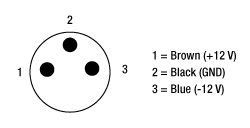
APD Female (Photodetector)
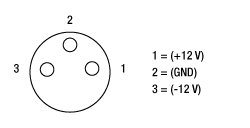
FIBER COUPLING
| Components for Fiber Couplinga | |
|---|---|
| Item # | Description |
| - | Free-Space Avalanche Photodetector |
| LM1XY(/M) | Translating Lens Mount for Ø1" Optics |
| SM1L10 | SM1 (1.035"-40) Lens Tube, 1" Long |
| - | Fiber Collimator (Dependent on Fiber) |
| AD11F or AD12F | SM1-Threaded Adapters for Ø11 or Ø12 mm Fiber Collimators (Dependent on Collimator) |
| - | Mounted Molded Aspheric Lens (Dependent on Collimator) |
| S1TM06, S1TM08, S1TM09, S1TM10, or S1TM12 |
SM1-Threaded Adapter for Molded Aspheric Lens Cell (Dependent on Lens) |
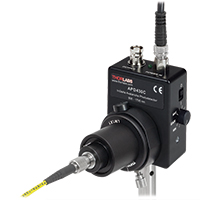
Click to Enlarge
Output from a fiber is coupled into the photodetector using an aspheric lens to focus the signal onto the detector active area.
Fiber Coupling to Free-Space APDs
A fiber coupling mechanism can be constructed for our free-space APDs using standard optomechanics. In fiber coupling applications, we recommend taking into account the divergence of light from the fiber tip to ensure that all of the signal is focused onto the detector active area. When using a standard fiber connector adapter with a detector with an active area smaller than Ø1 mm, high coupling losses and degradation of the frequency response may occur.
To achieve high coupling efficiency, a fiber collimation package, focusing lens, and X-Y translator should be used, as shown in the photo to the right. The avalanche photodetector is shown with a fiber collimator, lens tube collimator adapter, lens tube, and X-Y translation mount. An adapter inside the lens tube holds an aspheric lens (not visible) to focus the collimated light onto the active area of the detector. The X-Y translation mount corrects for any centering issues.
Please note that Thorlabs also offers the APD431C fiber-coupled Si photodetector, which features an M12 x 0.15-threaded flange that is directly compatible with our M12 x 0.5-threaded fiber connector adapters. This compact and robust mechanism allows for easy fiber coupling with high reproducibility. The M12 x 0.5-threaded flange can be added to any of Thorlabs' Avalanche Photodetectors to provide robust fiber-coupling capabilities. Please contact Tech Support for more information.
PULSE CALCULATIONS
Pulsed Laser Emission: Power and Energy Calculations
Determining whether emission from a pulsed laser is compatible with a device or application can require referencing parameters that are not supplied by the laser's manufacturer. When this is the case, the necessary parameters can typically be calculated from the available information. Calculating peak pulse power, average power, pulse energy, and related parameters can be necessary to achieve desired outcomes including:
- Protecting biological samples from harm.
- Measuring the pulsed laser emission without damaging photodetectors and other sensors.
- Exciting fluorescence and non-linear effects in materials.
Pulsed laser radiation parameters are illustrated in Figure 1 and described in the table. For quick reference, a list of equations is provided below. The document available for download provides this information, as well as an introduction to pulsed laser emission, an overview of relationships among the different parameters, and guidance for applying the calculations.
|
Equations: |
||||
 |
and |  |
||
 |
||||
 |
||||
 |
||||
Peak power and average power calculated from each other: |
||||
 |
and |  |
||
| Peak power calculated from average power and duty cycle*: | ||||
 |
*Duty cycle ( ) is the fraction of time during which there is laser pulse emission. ) is the fraction of time during which there is laser pulse emission. |
|||
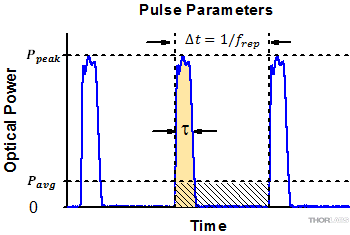
Click to Enlarge
Figure 1: Parameters used to describe pulsed laser emission are indicated in the plot (above) and described in the table (below). Pulse energy (E) is the shaded area under the pulse curve. Pulse energy is, equivalently, the area of the diagonally hashed region.
| Parameter | Symbol | Units | Description | ||
|---|---|---|---|---|---|
| Pulse Energy | E | Joules [J] | A measure of one pulse's total emission, which is the only light emitted by the laser over the entire period. The pulse energy equals the shaded area, which is equivalent to the area covered by diagonal hash marks. | ||
| Period | Δt | Seconds [s] | The amount of time between the start of one pulse and the start of the next. | ||
| Average Power | Pavg | Watts [W] | The height on the optical power axis, if the energy emitted by the pulse were uniformly spread over the entire period. | ||
| Instantaneous Power | P | Watts [W] | The optical power at a single, specific point in time. | ||
| Peak Power | Ppeak | Watts [W] | The maximum instantaneous optical power output by the laser. | ||
| Pulse Width |  |
Seconds [s] | A measure of the time between the beginning and end of the pulse, typically based on the full width half maximum (FWHM) of the pulse shape. Also called pulse duration. | ||
| Repetition Rate | frep | Hertz [Hz] | The frequency with which pulses are emitted. Equal to the reciprocal of the period. | ||
Example Calculation:
Is it safe to use a detector with a specified maximum peak optical input power of 75 mW to measure the following pulsed laser emission?
- Average Power: 1 mW
- Repetition Rate: 85 MHz
- Pulse Width: 10 fs
The energy per pulse:

seems low, but the peak pulse power is:

It is not safe to use the detector to measure this pulsed laser emission, since the peak power of the pulses is >5 orders of magnitude higher than the detector's maximum peak optical input power.
SELECTION GUIDE
Avalanche Photodetector Selection Guide
| Item # | Detector Type |
Wavelength Range |
3 dB Bandwidth | Active Area Diameter |
M Factor | Typical Max Responsivity |
Max Conversion Gaina |
Variable Gain |
Temperature Compensated |
Fiber-Coupledb |
|---|---|---|---|---|---|---|---|---|---|---|
| APD440A2 | UV Enhanced Silicon APD |
200 - 1000 nm | DC - 0.1 MHz | 1 mm | 5 - 50 | 25 A/W @ 600 nm (M = 50) | 1.25 x 109 V/W | - | ||
| APD410A2 | DC - 10 MHz | 0.5 mm | 5 - 50 | 25 A/W @ 600 nm (M = 50) | 12.5 x 106 V/W | - | ||||
| APD130A2 | DC - 50 MHz | 1 mm | 50 | 25 A/W @ 600 nm (M = 50) | 2.5 x 106 V/W | - | - | |||
| APD430A2 | DC - 400 MHz | 0.2 mm | 10 - 100 | 50 A/W @ 600 nm (M = 100) | 5.0 x 105 V/W | - | ||||
| APD410 | 5 - 900 MHzc | 0.2 mm | 50 | 22 A/W @ 650 nm (M = 50) | 4.5 x 104 V/Wd | - | ||||
| APD440A | Silicon APD | 400 - 1000 nm | DC - 0.1 MHz | 1 mm | 10 - 100 | 53 A/W @ 800 nm (M = 100) | 2.65 x 109 V/W | - | ||
| APD410A | DC - 10 MHz | 1.0 mm | 10 - 100 | 53 A/W @ 800 nm (M=100) | 26.5 x 106 V/W | - | ||||
| APD130A | DC - 50 MHz | 1 mm | 50 | 25 A/W @ 800 nm (M = 50) | 2.5 x 106 V/W | - | - | |||
| APD430A | DC - 400 MHz | 0.5 mm | 10 - 100 | 53 A/W @ 800 nm (M = 100) | 5.3 x 105 V/W | - | ||||
| APD431A | DC - 400 MHze | 0.5 mm | 10 - 100 | 53 A/W @ 800 nm (M = 100) | 5.3 x 105 V/W | |||||
| APD210 | 5 - 1000 MHzc | 0.5 mm | 100 | 50 A/W @ 800 nm (M = 100) | 2.5 x 105 V/Wf | - | ||||
| APD130C | InGaAs APD | 900 - 1700 nm | DC - 50 MHz | 0.2 mm | 10 | 9 A/W @ 1500 nm (M = 10) | 0.9 x 106 V/W | - | - | |
| APD410C | DC - 10 MHz | 0.2 mm | 4 - 20 | 18 A/W @ 1550 nm (M = 20) | 9.0 x 106 V/W | - | ||||
| APD430C | DC - 400 MHz | 0.2 mm | 4 - 20 | 18 A/W @ 1550 nm (M = 20) | 1.8 x 105 V/W | - | ||||
| APD431C | DC - 400 MHze | 0.2 mm | 4 - 20 | 18 A/W @ 1550 nm (M = 20) | 1.8 x 105 V/W | |||||
| APD450C | 1260 - 1620 nm | 0.3 - 1600 MHz | 1.5 mmg | 2 - 10 | 9 A/W @ 1550 nm (M = 10) | 45 × 103 V/W | - | |||
| APD310 | 850 - 1650 nm | 5 - 1000 MHzc | 0.04 mm | 30 | 0.9 A/W @ 1550 nm (M = 30) | 2.5 x 104 V/Wh | - |
Temperature-Compensated InGaAs Avalanche Photodetectors
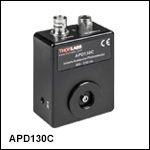
| Key Specificationsa | |
|---|---|
| Item # | APD130C(/M) |
| Detector Type | InGaAs APD |
| Wavelength Range | 900 - 1700 nm |
| Output Bandwidth (3 dB) | DC - 50 MHz |
| Active Area Diameter | 0.2 mm |
| Typical Max Responsivity | 9 A/W @ 1500 nm (M = 10) |
| Transimpedance Gain | 50 kV/A (50 Ω Termination) 100 kV/A (High-Z Termination) |
| Max Conversion Gainb | 0.9 × 106 V/W |
| M Factor | 10 |
| M Factor Temperature Stabilityc | ±2% (Typical); ±3% (Max) |
| Saturation Power (CW) | 4.2 µW |
| Minimum NEP (DC - 50 MHz)d | 0.46 pW/√Hz |
| Dimensions (W x H x D) | 2.97" x 2.00" x 1.08" |
- Temperature Compensated to Provide M Factor Stability of ≤±3% Over 18 to 28 °C
- Internal SM05 and External SM1 Threads Accept Fiber Adapters, Lens Tubes, and Other Components
- Power Supply Included
Thorlabs' APD130C(/M) Free-Space Avalanche Photodetector features an integrated thermistor that maintains an M factor stability of ±3% or better over 23 ± 5 °C by adjusting the bias voltage across the avalanche photodiode, supplying improved output stability in environments with temperature variations.
The orientation of the mechanical and electrical connections, combined with the compact design, ensures that these detectors can fit into tight spaces. Three 8-32 (M4) mounting holes, one on each edge of the housing, further ensure easy integration into complicated mechanical setups. The housing also provides compatibility with both our SM05 and SM1 Lens Tubes. An internally SM1-threaded cap is included.
Fiber Coupling Note:
For fiber-coupled applications, we do not recommend using fiber connector adapters such as Thorlabs' S120-FC due to the small size of the detector. High coupling losses and degradation of the frequency response may occur. To achieve high coupling efficiency, a fiber collimation package, focusing lens, and X-Y translator should be used. See the Fiber Coupling tab for details.
Part Number | Description | Price | Availability |
|---|---|---|---|
APD130C/M | InGaAs Avalanche Photodetector, Temperature Compensated, 900 - 1700 nm, M4 Taps | $2,672.83 | Today |
APD130C | InGaAs Avalanche Photodetector, Temperature Compensated, 900 - 1700 nm, 8-32 Taps | $2,672.83 | Today |
Variable-Gain, Temperature-Compensated Avalanche Photodetectors

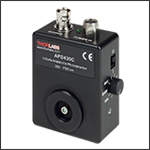
Click to Enlarge
The M Factor is controlled by a knob on the side of the APD.
- Continuously Variable Gain
- Temperature Compensated to Provide M Factor Stability of ±3% Over 18 to 28 °C
- Internal SM05 and External SM1 Threads Accept Fiber Adapters, Lens Tubes, and Other Components
- Power Supply Included
Thorlabs' APD410C(/M), APD430C(/M), and APD450C Free-Space Avalanche Photodetectors have a variable gain that can be controlled by a knob on the right side of the housing. The gain knob adjusts the reverse bias voltage across the photodiode, allowing the M factor to vary. Like the APD130C detectors above, these devices feature an integrated thermistor that maintains an M factor stability of ±3% or better over 23 ± 5 °C by adjusting the bias voltage across the avalanche photodiode. These detectors offer different bandwidth ranges and sensitivity.
The orientation of the mechanical and electrical connections, combined with the compact design, ensures that these detectors can fit into tight spaces. Three 8-32 (M4) mounting holes, one on each edge of the APD410C(/M) and APD430C(/M) housing, further ensure easy integration into complicated mechanical setups. The APD450C detector offers universal 8-32/M4 mounting holes. The housing also provides compatibility with both our SM05 and SM1 Lens Tubes. An internally SM1-threaded cap is included.
Fiber Coupling Note:
For fiber-coupled applications, we do not recommend using fiber connector adapters such as Thorlabs' S120-FC with the APD410C or APD430C detectors due to the small size of the sensors. High coupling losses and degradation of the frequency response may occur. To achieve high coupling efficiency, a fiber collimation package, focusing lens, and X-Y translator should be used. See the Fiber Coupling tab for details.
Please note that Thorlabs also offers the APD431C fiber-coupled Si photodetector, which features an M12 x 0.15-threaded flange that is directly compatible with our M12 x 0.5-threaded fiber connector adapters. This compact and robust mechanism allows for easy fiber coupling with high reproducibility. The M12 x 0.5-threaded flange can be added to any of Thorlabs' Avalanche Photodetectors to provide robust fiber-coupling capabilities. Please contact Tech Support for more information.
| Key Specificationsa | |||
|---|---|---|---|
| Item # | APD410C(/M) | APD430C(/M) | APD450C |
| Detector Type | InGaAs APD | ||
| Wavelength Range | 900 - 1700 nm | 1260 - 1620 nm | |
| Output Bandwidth (3 dB)b | DC - 10 MHz | DC - 400 MHz | 0.3 - 1600 MHz |
| Active Area Diameter | 0.2 mm | 75 µm, with Ø1.5 mm Ball Lens | |
| Typical Max Responsivity | 18 A/W @ 1550 nm (M = 20) | 9 A/W @ 1550 nm (M = 10) | |
| Transimpedance Gain | 250 kV/A (50 Ω Termination) 500 kV/A (High-Z Termination) |
5 kV/A (50 Ω Termination) 10 kV/A (High-Z Termination) |
5 kV/A (50 Ω Termination) |
| Max Conversion Gainc | 9.0 × 106 V/W | 1.8 × 105 V/W | 4.5 × 104 V/W (50 Ω Termination) |
| M Factor Adjustment Range | 4 - 20 (Continuous) | 2 - 10 (Continuous) | |
| M Factor Temperature Stabilityd | ±2% (Typical); ±3% (Max) | ||
| Saturation Power (CW) | 0.45 µW @ 1550 nm (M = 20) 2.25 µW @ 1550 nm (M = 4) |
22 µW @ 1550 nm (M = 20) 110 µW @ 1550 nm (M = 4) |
0.1 mW @ 1550 nm (M = 10) 0.5 mW @ 1550 nm (M = 2) |
| Minimum NEPe | 0.12 pW/√Hz (DC - 10 MHz) | 0.45 pW/√Hz (DC - 100 MHz) | 1.1 pW/√Hz (0.3 - 1600 MHz) |
| Dimensions (W x H x D) | 2.97" x 2.20" x 1.09" | 2.83" x 2.22" x 1.08" | |
Part Number | Description | Price | Availability |
|---|---|---|---|
APD410C/M | InGaAs Variable-Gain Avalanche Photodetector, Temperature Compensated, 900 - 1700 nm, DC - 10 MHz, M4 Taps | $2,733.41 | Today |
APD430C/M | InGaAs Variable-Gain Avalanche Photodetector, Temperature Compensated, 900 - 1700 nm, DC - 400 MHz, M4 Taps | $2,733.41 | Today |
APD450C | Customer Inspired! InGaAs Variable-Gain Avalanche Photodetector, Temperature Compensated, 1260 - 1620 nm, 0.3 - 1600 MHz, Universal 8-32 / M4 Taps | $1,876.98 | Today |
APD410C | InGaAs Variable-Gain Avalanche Photodetector, Temperature Compensated, 900 - 1700 nm, DC - 10 MHz, 8-32 Taps | $2,733.41 | Today |
APD430C | InGaAs Variable-Gain Avalanche Photodetector, Temperature Compensated, 900 - 1700 nm, DC - 400 MHz, 8-32 Taps | $2,733.41 | Today |
Variable-Gain, Temperature-Compensated, High-Speed Avalanche Photodetector

Applications
- Fast Laser Pulses
- Ultra-Low-Light Signals
- Temperature-Compensated Avalanche Photodiode
- Integrated Radio Frequency Amplifier
- Continuously Adjustable Gain Setting
- Long-Term Field Tested
- Free-Space Optical Input with Internal SM05 (0.535"-40) Threading
- Easy-to-Use Package
- Location-Specific (EU or US) Power Supply Included
Originally developed for the detection of the beat note signal between CW or pulsed lasers, Menlo Systems' APD310 InGaAs Avalanche Photodetector is ideally suited for applications requiring very high sensitivity for low-light input signals in the 850 - 1650 nm range. The APD avalanche photodiode series can provide an extremely sensitive alternative to traditional PIN photodiodes. It is also fast enough for the characterization of, for example, pulsed solid-state lasers on the nanosecond time scale.
The detector maintains high gain stability over the 10 °C to 40 °C temperature range by utilizing a temperature compensation circuit, which adjusts the ~150 V DC bias to ensure operation near the breakdown voltage. The 3 dB bandwidth of the AC-coupled device is 5 - 1000 MHz.
Models for both the visible and near infrared range are available. The compact design of these detectors allows for easy OEM integration.
The units are especially recommended for applications such as metrology when homodyne or heterodyne optical beat signals of weak power have to be detected and amplified in a highly efficient way.
Part Number | Description | Price | Availability |
|---|---|---|---|
APD310 | InGaAs Variable-Gain Avalanche Photodetector, Temperature Compensated, 850 - 1650 nm, 1 - 1600 MHz, M4 Tap | $3,036.30 | Today |
±12 VDC Regulated Linear Power Supply

- Replacement Power Supply for Avalanche Photodetectors Sold Above (Except Item # APD310)
- ±12 VDC Power Output
- Current Limit Enabling Short Circuit and Overload Protection
- On/Off Switch with LED Indicator
- Switchable AC Input Voltage (100, 120, or 230 VAC)
- 2 m (6.6') Cable with LUMBERG RSMV3 Male Connector
- UL and CE Compliant
The LDS12B ±12 VDC Regulated Linear Power Supply is intended as a replacement for the supply included with our APD series of avalanche photodetectors sold on this page, except for the APD310 photodetector. The cord has three pins: one for ground, one for +12 V, and one for -12 V (see diagram to the right). A region-specific power cord is shipped with the unit based on your location. This power supply can also be used with the PDA series of amplified photodetectors, PDB series of balanced photodetectors, PMM series of photomultiplier modules, and the FSAC autocorrelator for femtosecond lasers.
Part Number | Description | Price | Availability |
|---|---|---|---|
LDS12B | ±12 VDC Regulated Linear Power Supply, 6 W, 100/120/230 VAC | $93.55 | Today |


